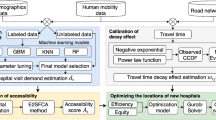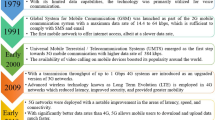Abstract
The paper makes new contributions to cost analysis and minimization of movement-based location management schemes in wireless communication networks. The main contributions of the paper are three-fold. First, we consider two different call handling models, that is, the call plus location update (CPLU) model and the call without location update (CWLU) model. We point out that all existing analysis of location update cost of a movement-based location management scheme (MBLMS) do not accurately capture the essence of the two models. Second, we analyze the exact location update cost of an MBLMS under both CPLU and CWLU models using a renewal process approach which has rarely been used before. We find that the location update cost of an MBLMS under the CWLU model is much easier to analyze than that of an MBLMS under the CPLU model. Furthermore, an MBLMS operated under the CWLU model has lower location update cost than an MBLMS operated under the CPLU model. Third, we are able to derive a closed form solution to the movement threshold that minimizes the total cost of location management in an MBLMS for the CPLU model when the inter-call time has an arbitrary distribution and the cell residence time has an Erlang distribution, and for the CWLU model when both inter-call time and cell residence time have arbitrary distributions. Such closed form solutions have not been available in the existing literature.


















Similar content being viewed by others
References
Abutaleb, A., & Li, V. O. K. (1997). Paging strategy optimization in personal communication systems. Wireless Networks, 3(3), 195–204.
Abutaleb, A., & Li, V. O. K. (1997). Location update optimization in personal communication systems. Wireless Networks, 3(3), 205–216.
Akyildiz, I. F., & Ho, J. S. M. (1995). Dynamic mobile user location update for wireless PCS networks. Wireless Networks, 1, 187–196.
Akyildiz, I. F., Ho, J. S. M., & Lin, Y.-B. (1996). Movement-based location update and selective paging for PCS networks. IEEE/ACM Transactions on Networking, 4, 629–638.
Akyildiz, I. F., McNair, J., Ho, J. S. M., Uzunalioğlu, H., & Wang, W. (1999). Mobility management in next-generation wireless systems. Proceedings of the IEEE, 87(8), 1347–1384.
Akyildiz, I. F., & Wang, W. (2002). A dynamic location management scheme for next-generation multitier PCS systems. IEEE Transactions on Wireless Communications, 1(1), 178–189
Alba, E., García-Nieto, J., Taheri, J., & Zomaya, A. (2008). New research in nature inspired algorithms for mobility management in GSM networks. Lecture Notes in Computer Science, 4974, 1–10.
Bar-Noy, A., Feng, Y., & Golin, M. J. (2007). Paging mobile users efficiently and optimally. Proceedings of the 26th IEEE International Conference on Computer Communications, pp. 1910–1918.
Bar-Noy, A., Kessler, I., & Sidi, M. (1995). Mobile users: To update or not update?. Wireless Networks, 1, 175–185
Baumann, F. V., & Niemegeers, I. G. (1994). An evaluation of location management procedures. Proceedings of IEEE International Conference on Universal Personal Communications, pp. 359–364.
Brown, T. X., & Mohan, S. (1997). Mobility management for personal communications systems. IEEE Transactions on Vehicular Technology, 46(2), 269–278.
Casares-Giner, V., & Mataix-Oltra, J. (2002). Global versus distance-based local mobility tracking strategies: a unified approach. IEEE Transactions on Vehicular Technology, 51(3), 472–485.
Cayirci, E., & Akyildiz, I. F. (2002). User mobility pattern scheme for location update and paging in wireless systems. IEEE Transactions on Mobile Computing, 1(3), 236–247.
Cox, D. R. (1962). Renewal theory. London: Methuen & Co. Ltd.
Escalle, P. G., Giner, V. C., & Oltra, J. M. (2002). Reducing location update and paging costs in a PCS network. IEEE Transactions on Wireless Communications, 1(1), 200–209.
Fang, Y. (2002). General modeling and performance analysis for location management in wireless mobile networks. IEEE Transactions on Computers, 51(10), 1169–1181.
Fang, Y. (2003). Movement-based mobility management and trade off analysis for wireless mobile networks. IEEE Transactions on Computers, 52(6), 791–803.
Fang, Y. (2005). Modeling and performance analysis for wireless mobile networks: A new analytical approach. IEEE/ACM Transactions on Networking, 13(5), 989–1002.
Fang, Y., Chlamtac, I., & Lin, Y.-B. (2000). Potable movement modeling for PCS networks. IEEE Transactions on Vehicular Technology, 49(4), 13560–1363
Furht, B., & Ilyas, M. (eds) (2003). Wireless internet handbook—technologies, standards, and applications. Boca Raton, FL: CRC Press.
Glisic, S. G. (2006). Advanced wireless networks—4G technologies. Chichester, England: Wiley.
Ho, J. S. M., & Akyildiz, I. F. (1995). Mobile user location update and paging under delay constraints. Wireless Networks, 1, 413–425.
Kleinrock, L. (1975). Queueing systems, Vol. 1: Theory. Wiley: New York.
Kruijt, N. E., Sparreboom, D., Schoute, F. C., & Prasad, R. (1998). Location management strategies for cellular mobile networks. IEE Electronics Communication Engineering Journal, 10(2), 64–72.
Kyamakya, K., & Jobmann, K. (2005). Location management in cellular networks: classification of the most important paradigms, realistic simulation framework, and relative performance analysis. IEEE Transactions on Vehicular Technology, 54(2), 687–708.
Li, J., Kameda, H., & Li, K. (2000). Optimal dynamic mobility management for PCS networks. IEEE/ACM Transactions on Networking, 8(3), 319–327.
Li, J., Pan, Y., & Jia, X. (2002). Analysis of dynamic location management for PCS networks. IEEE Transactions on Vehicular Technology, 51(5), 1109–1119.
Lin, Y.-B. (1997). Reducing location update cost in a PCS network. IEEE/ACM Transactions on Networking, 5(1), 25–33.
Madhow, U., Honig, M. L., & Steiglitz, K. (1995). Optimization of wireless resources for personal communications mobility tracking. IEEE/ACM Transactions on Networking, 3(12), 698–707.
Ng, C. K., & Chan, H. W. (2005). Enhanced distance-based location management of mobile communication systems using a cell coordinates approach. IEEE Transactions on Mobile Computing, 4(1), 41–55.
Rodríguez-Dagnino, R. M., & Takagi, H. (2003). Counting handovers in a cellular mobile communication network: Equilibrium renewal process approach. Performance Evaluation, 52, 153–174.
Rodríguez-Dagnino, R. M., & Takagi, H. (2007). Movement-based location management for general cell residence times in wireless networks. IEEE Transactions on Vehicular Technology, 56(5), 2713–2722.
Rose, C. (1996). Minimizing the average cost of paging and registration: A timer-based method. Wireless Networks, 2(2), 109–116.
Rose, C. (1999). State-based paging/registration: A greedy technique. IEEE Transactions on Vehicular Technology, 48(1), 166–173.
Rose, C., & Yates, R. (1995). Minimizing the average cost of paging under delay constraints. Wireless Networks, 1, 11–219.
Saraydar, C. U., Kelly, O. E., & Rose, C. (2000). One-dimensional location area design. IEEE Transactions on Vehicular Technology, 49(5), 1626–1632.
Subrata1, R., & Zomaya, A. Y. (2003). Dynamic location management for mobile computing. Telecommunication Systems, 22(1–4), 169–187.
Tabbane, S. (1997). Location management methods for third-generation mobile systems. IEEE Communications Magazine, 35, 72–84.
Taheri, J., & Zomaya, A. Y. (2007). A simulated annealing approach for mobile location management. Computer Communications, 30(4), 714–730
Taheri, J., & Zomaya, A. Y. (2007). A combined genetic-neural algorithm for mobility management. Journal of Mathematical Modelling and Algorithms, 6(3), 481–507
Taheri, J., & Zomaya, A. Y. (2007). Clustering techniques for dynamic location management in mobile computing. Journal of Parallel and Distributed Computing, 67(4), 430–447
Taheri, J., & Zomaya, A. Y. (2008). Bio-inspired algorithms for mobility management. Proceedings of the International Symposium on Parallel Architectures, Algorithms, and Networks, pp. 216–223
Taheri, J., & Zomaya, A. Y. (2009). A simulation tool for mobility management experiments. International Journal of Pervasive Computing and Communications, 5(3), 360–379.
Verkama, M. (1996). Optimal paging—A search theory approach. Proceedings of IEEE International Conference on Universal Personal Communications, pp. 956–960.
Wan, G., & Lin, E. (1999). Cost reduction in location management using semi-realtime movement information. Wireless Networks, 5, 245–256
Wang, W., Akyildiz, I. F., Stüber, G. L., & Chung, B.-Y. (2001). Effective paging schemes with delay bounds as QoS constraints in wireless systems. Wireless Networks, 7, 455–466.
Yener, A., & Rose, C. (1998). Highly mobile users and paging: optimal polling strategies. IEEE Transactions on Vehicular Technology, 47(4), 1251–1257.
Zhang, Y., Zheng, J., Zhang, L., Chen, Y.,& Ma, M. (2006). Modeling location management in wireless networks with generally distributed parameters. Computer Communications, 29(12), 2386–2395.
Zwillinger, D. (ed) (1996). Standard mathematical tables and formulae (30th ed.). Boca Raton, FL: CRC Press.
Acknowledgments
The author is grateful to two anonymous reviewers and the editor for their suggestions to improve the paper.
Author information
Authors and Affiliations
Corresponding author
Rights and permissions
About this article
Cite this article
Li, K. Cost analysis and minimization of movement-based location management schemes in wireless communication networks: a renewal process approach. Wireless Netw 17, 1031–1053 (2011). https://doi.org/10.1007/s11276-011-0332-0
Published:
Issue Date:
DOI: https://doi.org/10.1007/s11276-011-0332-0




